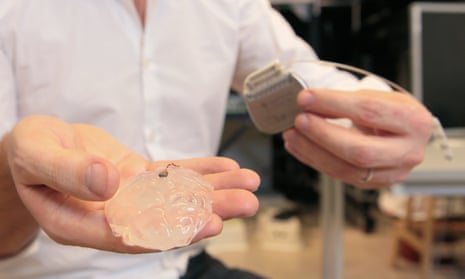Partially-paralysed monkeys have learned to walk again with a brain implant that uses wireless signals to bypass broken nerves in the spinal cord and reanimate the useless limbs.
The implant is the first to restore walking ability in paralysed primates and raises the prospect of radical new therapies for people with devastating spinal injuries.
Scientists hope the technology will help people who have lost the use of their legs, by sending movement signals from their brains to electrodes in the spine that activate the leg muscles.
One rhesus macaque that was fitted with the new implant regained the ability to walk only six days after it was partially paralysed in a surgical procedure that severed some of the nerves that controlled its right hind leg.
“It was a big surprise for us,” said Grégoire Courtine, a neuroscientist who led the research at the Swiss Federal Institute of Technology. “The gait was not perfect, but it was almost like normal walking. The foot was not dragging and it was fully weight bearing.”
A second animal in the study that received more serious damage to the nerves controlling its right hind leg recovered the ability to walk two weeks after having the device fitted, according to a report published in the journal, Nature. Both monkeys regained full mobility in three months.
The “brain-spine interface” is the latest breakthrough to come from the rapidly-advancing area of neuroprosthetics. Scientists in the field aim to read intentions in the brain’s activity and use it to control computers, robotic arms and even paralysed limbs.
Courtine’s team spent seven years developing the approach which has four major components. The first is a brain implant which records activity from 50 to 100 neurons that help to control the monkey’s right hind leg. This fizz of activity is beamed wirelessly in real time to a computer, where it is decoded into intentions and sent to the third part of the system, a pulse generator. The pulses it produces are then beamed to a second implant fitted at the base of the monkey’s spine. Here, the implant stimulates spinal nerves that activate specific groups of leg muscles.
The brain implant picks up only broad information about movement, starting with the intention to walk, which the scientists can detect before the animal takes a step. Once in motion, the brain activity controls whether the leg pushes backwards or lifts and moves forwards. In able animals, the spine processes these brain signals and activates the muscles needed for walking. In those with serious spinal injuries, the signals do not get through.
The system is built from components that are already approved for human use. As such, Courtine believes it could be ripe for human trials in as little as five years. The first application of the system is likely to be in hospital rehabilitation units. To help humans walk on two paralysed legs is a harder challenge, because the system has to control balance and steering as well as simple gait movements. The computer and batteries needed to run the system would need to be wearable or implanted too.
“I don’t imagine someone walking down the street with a brain-spine interface. That’s a bit extravagant at this stage. But in the next five years, someone with a spinal injury could have a better recovery after being implanted with this and having robot-assisted rehabilitation,” Courtine told the Guardian.
Scientists are excited about the implant’s potential in rehabilitation units because it could help the majority of spinal injury patients whose spinal cords are not completely severed. In these patients some nerve fibres are still intact, but they are insufficient to move limbs properly.
By re-establishing a link between the brain and the spinal cord, the implant could help the remaining nerves to strengthen their connections, and ultimately regain control of lost functions. “The real impact of this system is to promote re-organisation of the nervous system in rehabilitation,” said Courtine. “The idea is that over time, if the injury is not too severe, you can actually recover voluntary movement without needing the technology.”
Andrew Jackson at Newcastle University’s Institute of Neuroscience said the work was a “major step” towards recovering lost movement with neural implants. “When you think about bipedal walking, balance and steering are a challenge, but optimistically this could be used to allow people to walk with some kind of support, such as a frame,” he said.
But Jackson agrees that the device could first appear in rehabilitation units. To improve recovery even more, he said it could be used in programmes that include other new procedures, such as continuous spinal stimulation, which makes nerve fibres in the spine more responsive to weakened signals from the brain. “Some of the first applications may well be in rehabilitation and produce lasting results,” he said.
A feasibility study has already begun at Lausanne University Hospital in Switzerland to test the therapeutic effects of the spine part of the interface in people with spinal cord injuries. Jocelyne Bloch, a neurosurgeon at the hospital, said: “For the first time, I can imagine a completely paralysed patient able to move their legs through this brain-spine interface.”

Comments (…)
Sign in or create your Guardian account to join the discussion